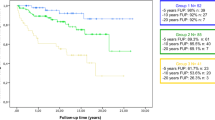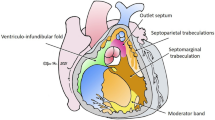Abstract
Background and Purpose:
Primary repair of tetralogy of Fallot (TOF) has been favored in many centers for years now and results and advantages of this management seem to verify this procedure. The authors wanted to know, if the age at the time of surgery and the surgical techniques had an influence on the long-term results.
Patients and Methods:
Between 1992 and 2003, 124 patients underwent complete repair of TOF at the University Hospital Münster, Germany. Patients were subdivided into two groups based on their age (< 1 year and > 1 year of age). Patients in whom a transannular patch (TAP) was used were compared with those without (NTAP), or in whom a conduit was used.
Results:
Overall mortality was 8%, with an average age of death of 9.53 years (range 0.06–19.77 years). The patients’ age at the time of surgery affected their survival as only two cases of death were reported among the group of children < 1 year of age (3.2%) whereas eight patients were older (12.9%; p = 0.0483). Six patients died within the first 30 days post surgery. Reoperation had to be performed in 21 cases, 13 (61.9%) of these patients were < 1 year of age at the time of surgery, eight were older (38.1%). A TAP, NTAP or conduit treatment did not show significant differences in long-term survival or freedom from reoperation.
Conclusion:
Early repair of TOF within the 1st year of life can be recommended, because mortality is lower than in patients treated at a higher age. There seems no significant difference in the reintervention rate between patients treated within the 1st year of life or later.
Zusammenfassung
Hintergrund und Ziel:
Die primäre Korrektur der Fallot-Tetralogie (TOF) wird in vielen Zentren favorisiert, und die Ergebnisse und Vorteile scheinen dieses Vorgehen zu rechtfertigen. In der vorliegenden Studie sollte untersucht werden, inwieweit das Alter der Patienten zum Zeitpunkt der Operation und die chirurgische Technik einen Einfluss auf die langfristigen Ergebnisse haben.
Patienten und Methodik:
Zwischen 1992 und 2003 wurden 124 Patienten mit TOF an der Universitätsklinik Münster korrektiv operiert. Die Patienten wurden, basierend auf dem Alter zum Zeitpunkt der Operation, in zwei Gruppen unterteilt (< 1 Jahr oder > 1 Jahr). Patienten, bei denen zur Korrektur ein transanulärer Patch (TAP) verwendet wurde, wurden mit Patienten verglichen, die keinen TAP erhielten (NTAP) oder bei denen ein Conduit vom rechten Ventrikel zur Pulmonalarterie implantiert wurde.
Ergebnisse:
Die Gesamtmortalität betrug 8% mit einem durchschnittlichen Alter von 9,53 Jahren (0,06–19,77 Jahre). Das Alter zum Zeitpunkt der Operation beeinflusste das Überleben, da nur zwei Todesfälle in der Gruppe der Patienten < 1 Jahr auftraten (3,2%), während acht Patienten der älteren Gruppe verstarben (12,9%; p = 0,0483). Sechs Patienten verstarben in den ersten 30 postoperativen Tagen. Eine Reoperation musste in 21 Fällen durchgeführt werden, 13 (61,9%) dieser Patienten waren zum Zeitpunkt der Operation < 1 Jahr, acht waren älter (38,1%). Die Art der Operation (TAP, NTAP oder Conduit) hatte keinen signifikanten Einfluss auf das Überleben oder die Reoperationsrate.
Schlussfolgerung:
Eine frühe Korrekturoperation der TOF kann empfohlen werden, da die Mortalität niedriger ist als bei später operierten Patienten. Es scheint keine Unterschiede bezüglich der Reinterventionsrate zwischen Patienten, die innerhalb des 1. Lebensjahrs oder später therapiert wurden, zu geben.
Similar content being viewed by others
Author information
Authors and Affiliations
Corresponding author
Rights and permissions
About this article
Cite this article
Gerling, C., Rukosujew, A., Kehl, HG. et al. Do the Age of Patients with Tetralogy of Fallot at the Time of Surgery and the Applied Surgical Technique Influence the Reoperation Rate?. Herz 34, 155–160 (2009). https://doi.org/10.1007/s00059-009-3169-x
Received:
Accepted:
Published:
Issue Date:
DOI: https://doi.org/10.1007/s00059-009-3169-x




